"It truly was hell." How to reflect the first blow to Stalingrad
Soviet counter strike
To support the garrison of Stalingrad, the Stavka decided to launch a new counterattack from the north and restore a united front with the 62nd Army. To organize the counteroffensive, General G.K. Zhukov again arrived. The new offensive was planned to be carried out by the forces of the 1st Guards and 24th armies, but on a different site — south of the Kotluban station. The 1st Guards Army was actually re-formed: transferring its lane to neighbors, Moskalenko’s headquarters was redeployed to the joint of the 4th tank and the 24th Army, where it received 8 new divisions concentrated on a 12-kilometer section of the front. The army was significantly strengthened by artillery and tanks: RGK artillery; 4th, 7th and 16th tank corps, replenished their material part; three separate tank brigades. The Guards Army received the task of delivering a strike from the Kotluban region in the general direction to Gumrak, destroying the opposing enemy forces and connecting with Chuikov’s troops.
In the first echelon, three tank brigades, as well as troops from the 7 tank corps of Rotmistrov, attacked the infantry directly. The 4 and 16 tank corps constituted the mobile group of the army, which received the task of developing success in breaking through the defenses of the enemy in the first echelon. At the same time, the 16 corps under the command of General A.G. Maslov was to be introduced following the 4 case of General A.G. Kravchenko.
The Germans had a well-prepared defense in the strike area. The leading edge passed along the crests of the dominant heights. They covered the firing positions of artillery and all movements in the depths of the German defense. The surrounding terrain from these heights was viewed for miles. The defenses were kept by the German 60-I, 3-I motorized and 79-I infantry divisions. Thus, the Soviet troops again faced a frontal attack on the bare steppe.
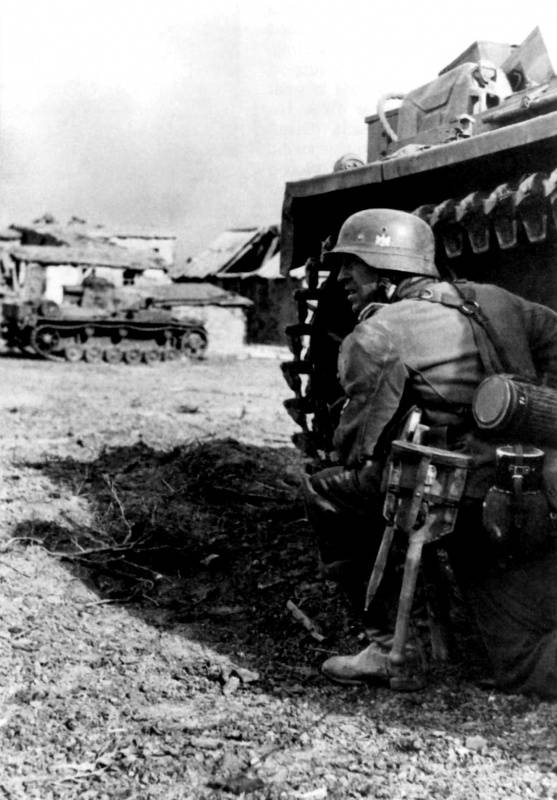
German soldier hiding from the fire behind the tank PzKpfw III during the fighting on the outskirts of Stalingrad
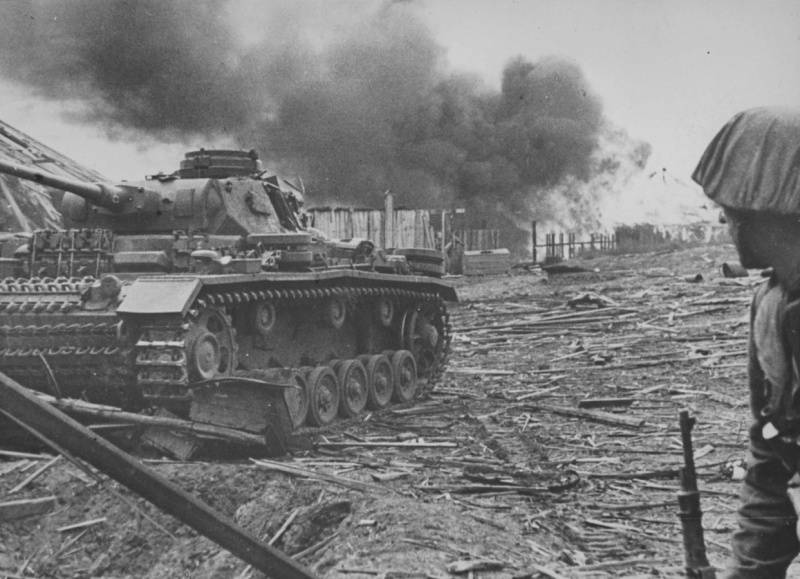
German soldier and tank Pz.Kpfw. III during the battle on the outskirts of the city
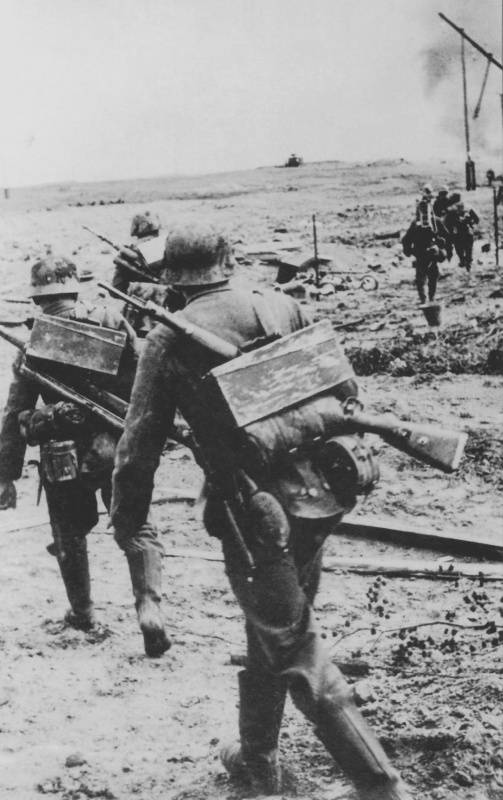
German soldiers change positions. Photo source: http://waralbum.ru/
The offensive began in the morning of September 18 1942. The Germans again knew about the Russian offensive and conducted their artillery preparation before the Soviet attack. German artillery struck at the concentration sites of the Soviet troops. Then the Soviet army conducted a half-hour artillery preparation, and tank brigades attacked the front edge of the enemy defenses. Overcoming the stubborn resistance of the enemy, they advanced 1-1,5 km and managed to climb the ridges of heights. But to break the defense to all its depth failed. To increase the impact, in the 14 watch, Moskalenko threw the 4 tank corps and two second-tier divisions into battle. However, they were late with access to the dominant heights. At 18 hours, the German infantry, reinforced by 50 tanks, launched a counterattack and dropped our troops that had thinned and not consolidated from the heights. By this time, the Soviet tanks were knocked out, escort artillery lagged behind in the morning, the bloodless infantry could not restrain the enemy strike.
Over the next four days, Soviet divisions continued fruitless attacks, but again failed to take the crest of heights. On September 23, the 16th Panzer Corps was thrown into the offensive. However, its units could not reach the goal, attacking the enemy head-on in the same areas and directions where the 4th and 7th corps had previously tried to break through. The previous mistakes in interaction continued to affect: tank formations, breaking through the enemy defenses and finding themselves in its depths, lost the support of infantry, artillery and aviation. The Germans skillfully cut off our infantry from tanks with machine-gun, mortar and artillery fire (our artillery was not able to suppress the bulk of the firing positions and points of the enemy), pressed infantry to the ground with air attacks; Soviet tanks were left without infantry support and ran into strong opposition from German artillery, including anti-tank, and tanks from the depths of defense. At the same time, our artillery and aviation could not provide full support to the armored formations that had broken through forward.
The offensive continued until the end of September, the troops suffered significant losses, but failed to break through the defense of the German army. As a result, the 1-I Guards Army was disbanded, and what was left of it was transferred to the 24-th army. The hope that a counterattack would at least distract part of the German forces from Stalingrad was also not justified. The Germans removed only part of the aircraft from Stalingrad. The onslaught of German ground forces almost did not weaken.
The command of the 62 Army also received an order: simultaneously with the troops of the Stalingrad Front to strike in the direction of the north-western outskirts of the city and destroy the enemy in the area. The offensive launched by the commander Chuikov 19 in September led to 3-day encounters in the area of Mamayev Kurgan and the village of Rynok. These counterattacks yielded no results and swallowed up all the already minimal reserves of the army.
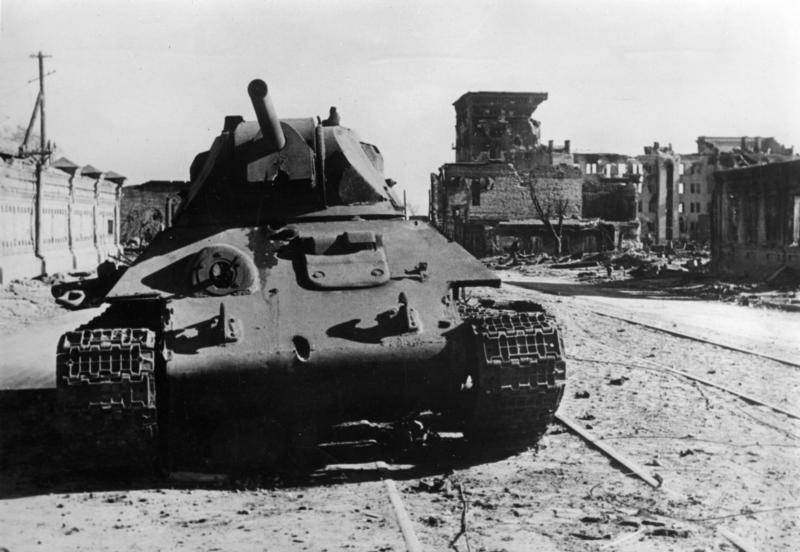
The wounded Soviet tank T-34 in Stalingrad. October 1942 of the year
Completion of the first assault
Meanwhile, the Germans had regrouped their troops. The 48 tank corps, part of the Goth tank army, was reassigned to the 6 army. The 24-I tank division and the 389-I infantry division withdrawn from the northern sector were transferred to the area to the west of Orlovka. In the center was heading from the area north of the Settlement 295-I infantry division. The regrouping of the troops was carried out in such a way as to concentrate their main efforts against the center and the northern part of the city.
On September 21, on the front from Mamayev Kurgan to the Tsatsaritsyn part of the city, the Germans launched an offensive with five divisions. By noon, due to the break of communication lines, Chuikov lost control of his left flank. September 22 The 62 Army was cut in two. At the site, Rodimtsev's division, which literally was a bone-worn division (for example, from the 1 Battalion of the 42 Guards Regiment defending the station, 6 people survived), the Germans reached the central crossing north of the Tsaritsa River. From here they were able to view almost the entire rear of the army and conduct an offensive along the coast, cutting off the Soviet units from the river.
General Rodimtsev recalled: ““ The fighting that unfolded in the early morning of September 22 at the division site, in terms of tension, bitterness and casualties, surpassed all previous battles that guards had to wage in the city. Among the flames and smoke, under the continuous fire of machine guns, artillery and tanks, under the bombing strikes of enemy aircraft, the guards fought to the death, defending every street, every house. Violent melee battles flared up every now and then. It truly was hell. I was not in one battle, but I had the opportunity to participate in such a fight for the first time. ”
Rodimtsev's guards entrenched on the coastal strip in the central part of the city, and the Germans were no longer able to recapture anything here. “They died there, but the people did not leave!” Said General Rodimtsev. In order to restore the defense, the commander of September Chuykov 23 threw a newly arrived 284 division of lieutenant colonel N. F. Batyuk into the counterattack (10 thous. Fighters). During the 2-day fierce battle, the enemy’s advance from the central pier area to the north was suspended. But it was not possible to connect with the 42 and 92 of the rifle brigades operating beyond the Tsaritsa River. Their remnants retreated beyond the Volga. Having freed their hands on the southern flank, the Germans began to transfer parts from there to Mamayev Kurgan and to the north.
To restore the supply of Chuikov’s army, new marinas and water communications were urgently organized: the first in the region of Verkhnyaya Akhtuba, the second in the region of Skurdi, the third in the region of Tumak. From here on the ships and ships of Volzhskaya flotilla and in boats, cargo was transported to the marinas at the Krasny Oktyabr factory and at the village of Spartanovka. A pedestrian bridge was built on iron barrels from the Barricades factory to Zaitsevsky Island, and a boat ferry operated between the island and the left bank of the Volga. Rifle brigades operating near the Tsaritsa River were supplied independently through the island of Golodny. In total, during the defense, about 100 thousand soldiers and officers, 11429 tons of cargo, etc., were transported to the right bank.
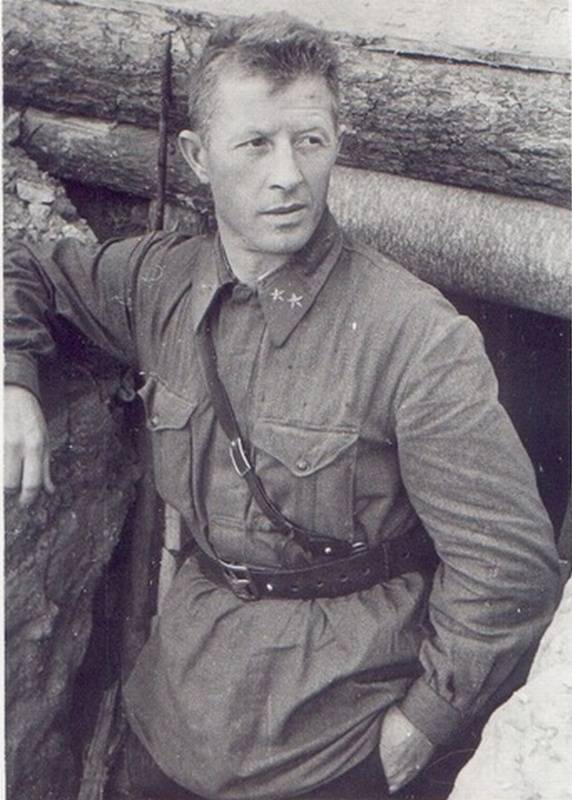
The commander of the 13 Guards Division, which participated in the defense of Stalingrad, Hero of the Soviet Union, Major General Alexander Ilyich Rodimtsev near the staff dugout. Stalingrad, September 1942
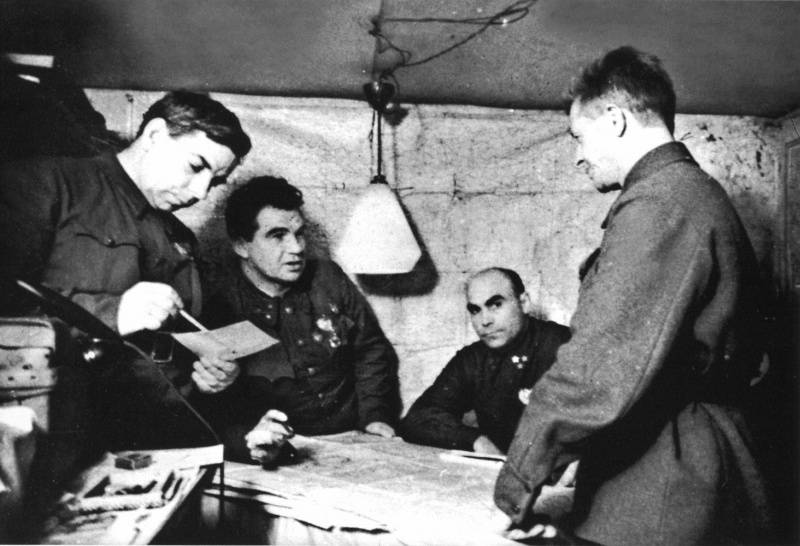
In the photo from left to right: Chief of Staff Major General Nikolai Ivanovich Krylov, Lieutenant General Vasily Ivanovich Chuikov, Lieutenant General Kuzma Akimovich Gurov, Major General Alexander Ilyich Rodimtsev
Results
By the evening of September 24, fights in the city center began to subside, the Soviet army repulsed the first assault. Thus, by 26 September, after 13 days of stubborn struggle in the city, the enemy captured the center of the city and fought in its southern part. However, the enemy was unable to fulfill the main task set for him: to seize the entire bank of the Volga near Stalingrad.
September 24. A. Hitler dismissed the Chief of the General Staff of the Ground Forces, Colonel-General Halder, who was appointed to this post before the start of World War II. He was blamed for the failure of operations to seize Stalingrad and the Caucasus. German military researchers wrote that Halder’s dismissal was caused by his sharp disagreements with the Fuhrer on the question of further operations, especially in the Stalingrad sector. G. Durr, in particular, noted: “The chief of the general staff of the land forces demanded an end to the offensive on Stalingrad; 24 September he was fired. " Von Butlar also draws a similar picture: “Meanwhile, the main command of the ground forces had serious disagreements between Hitler and the chief of the General Staff Halder ... he always tried to paint Hitler a true picture of the situation and show that the capabilities of the troops have a certain limit. In his assessment of the forces and plans of the enemy, Halder wanted to show the perspective of the battle on the Volga as accurately as possible. ”
Instead of Halder, Kurt Zeitzler was appointed General of the Infantry, who had previously been Chief of Staff of Army Group D on the Western Front. In the new chief of staff, Hitler found a persistent executor of his intentions who was fanatically loyal to him. Zeitzler persistently sought to implement the plans for the 1942 summer campaign. As a result, the German High Command did not carry out “work on the mistakes” in the Stalingrad sector. In the German Stavka they believed that the Red Army was defeated, had no serious reserves and was not able to organize a counterattack. The Fuhrer was sure that Stalingrad would soon be taken. Hitler, speaking at the 30 September 1942 of the Reichstag, said: "We will storm Stalingrad and take it - you can rely on it ... If we have taken something, we cannot be moved from there."
It is worth noting that the battles in Stalingrad were radically different from military operations in the field. The city buildings dissected the battle formations of the advancing German divisions; they had to act as regimental and battalion groups. Soviet units created strongholds in especially powerful, durable buildings with small garrisons that could lead the battle in the environment. During the aviation and artillery preparation of the Wehrmacht, our troops tried to get very close to the enemy, reducing their losses to a minimum. With the same purpose, they went to close combat so that the enemy could not fully use his advantage in aviation, artillery and tanks. The defenders of the city were the first in the Red Army to use this method of defensive actions in large quantities, such as skipping German tanks, which were met by anti-tank artillery and anti-tank guns in the depth of the defense. At this time, the enemy’s infantry was cut off with small-arms fire. weapons, mortars. The city is well recommended snipers. They actively used engineering barriers, learned to disguise, covertly maneuver and attack suddenly. For the first time during the war, the soldiers appreciated the helmets: during shelling, bricks and debris falling from the upper floors caused heavy injuries, or even killed.
Soldiers and junior commanders in urban battles received unprecedented freedom in their actions. In Stalingrad, in the conditions of street battles, daily fierce battles of small groups, and even individual fights, the individual qualities of each fighter, his desire to survive and win, gained importance. Those of the recruits who survived after the first attacks and fights, became real hardened fire and iron fighters. The highest commander was usually the battalion commander who fought and died with the soldiers. This led to a significant increase in confidence in their commanders and an increase in initiative. The commander-in-chief of Eremenko during this period mainly played the role of the head of the rear, ensuring the supply of the 62 army, and did it well. The battle led Chuikov and his commanders.
“It was necessary to constantly invent something new,” recalls Krylov. - And many people were engaged in this with enthusiasm, even with passion, from senior commanders and staff officers to ordinary soldiers. People's sense of personal responsibility for the outcome of the battle escalated, the initiative, the ability to dare developed, the fighters learned to think like a commander ”(N. Krylov. The Stalingrad Frontier. M .: Voenizdat, 1984).
The same is noted by Colonel Isakov: “Each attack required its solution and was not much like the previous ones. Naturally, in such peculiar conditions, the role of branch commanders, platoon and company commanders increased immeasurably. Often they had to act independently, sometimes even in isolation from other units. Therefore, initiative, ingenuity and resourcefulness have become more and more important ”(I.I. Isakov. Commanders become husband in battles. M .: Voenizdat, 1968.). Among the most striking examples was the sniper movement. Arrows such as Zaitsev, Chekhov, Ilyin, became real heroes in Stalingrad.
Was born and tactics assault battle. Along with platoons and squads, new tactical units appeared - small in number, but mobile and well-prepared and armed assault groups. They were armed with machine guns, light machine guns, melee weapons, grenades, tolovy charges and flamethrowers. They were followed by fastening groups with machine-gun machine guns, light mortars, anti-tank guns and mines. So, the experience of positional battles of the First World War was revived, when small assault groups were also used to storm powerful enemy positions.
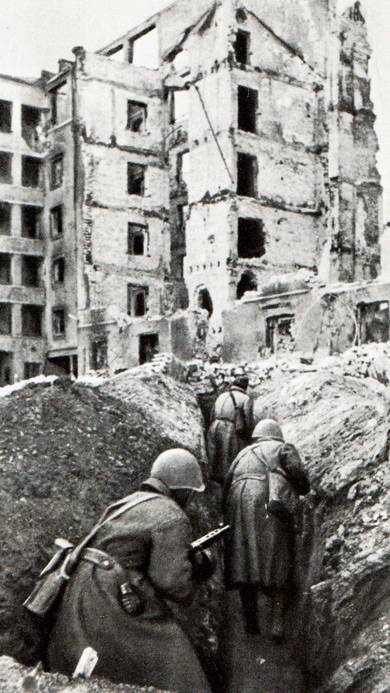
Street fighting in Stalingrad. Autumn 1942
- Alexander Samsonov
- 1942 Campaign
The Third Reich again goes on the offensive.
"The whole Russian front was falling apart ..." Wehrmacht breakthrough in the southern strategic direction
Stalingrad Fortress
1942 year. "The operation in the south develops without stopping"
How the German army broke through to Stalingrad
Expectations to take Stalingrad a sudden blow failed
Breakthrough of the 6 of the German army to the northern outskirts of Stalingrad
Defeat of the Crimean Front
"The spirit of optimism ... vital at the command post of the front." Kharkov disaster of the Red Army
Khrushchev dumped all the blame for the Kharkov catastrophe on Stalin
How the Wehrmacht stormed the Caucasus
Battle for the Caucasus: no invasions from land
The battle for the "black gold" of the Caucasus
How failed operation "Edelweiss"
"Soviet troops fought for every inch of land ..."
"Verdun of World War II ..."
Information